Based on the data and technologies included in the announcement, it looks very much like Nvidia can cement its dominance for years.
Those who followed the rumors that have been pouring in recently, could not hear many surprises during the company’s CES 2025 presentation. A generational change always generates enormous interest, as the heart of the PC gaming community primarily beats violently when the favorite title runs with maximum visibility and speed, and the necessary hardware is also available.
The RTX craze has experienced many highs and lows, but the fact is that the ecosystem cherished by Nvidia works anyway, is commercially successful, and according to various databases and records, the popularity of the GeForce brand is unbroken. This line is carried forward and strengthened by the RTX 50 generation based on the Blackwell architecture, whose flagship has amazing parameters and performance.
AI gaming condensed into 92 billion transistors
It is natural that everyone pays attention to what the maximum configuration intended for gaming can do, and Nvidia accordingly kicked off the presentation part announcing the new generation. Huge figures, significant acceleration compared to the previous generation, brutal chip construction and support for the new GDDR7 memory standard. The GeForce RTX 5090 can be seen as a separate product just like its predecessor, 21,760 stream processors have been integrated into the GB202-300 chip, which is more than double the figure compared to the RTX 5080, and is 33% thicker compared to the 4090.
We cover the detailed architecture analysis in our test, double RT performance and 1.5 times increase in shader calculations compared to the RTX 40 chip show that the engineers have done the homework required for a generation change. The three-fold increase measured in AI calculations is not a cakewalk, but the 32 GB of GDDR7 memory, which, thanks to the 512-bit memory bus, operates at a maximum data transfer rate of nearly 1.8 TB/s will certainly excite the majority.
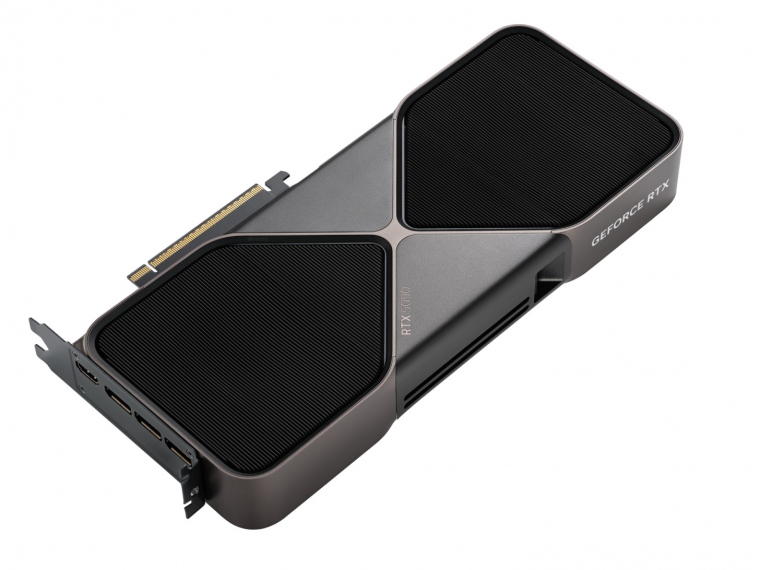
The two-slot design of the reference card is excellent, the fins fitted to the five heat pipes starting from the vapor chamber cooling block are ventilated by two fans, presumably capable of high air transport. Based on the announcements of the partner manufacturers, the monsters will dominate, we are curious to see what heat production indicators the flagship tuned to 575 W power consumption has. Speaking of consumption, the card can still be operated via the 16-pin 12V power connector, but its PCIe management has jumped to the 5.0 standard, and the bandwidth is required for such a GPU.
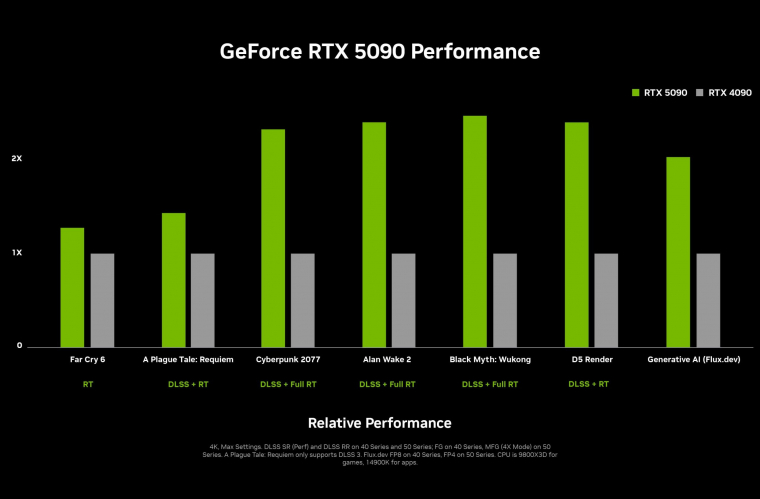
The goal is no longer the 4K 60 fps gaming experience, but we go much higher, up to 240 fps, or we can go for ray-tracing projected to 8K resolution, the DisplayPort 2.1b UHBR20 connectors integrated on the back support the display up to 8K 165 Hz . However, this experience does not come cheaply, aside from the price tag of the corresponding displays, the starting price of the GeForce RTX 5090 is USD 1,999, which can easily rise to USD 2,199-2,399 in the range of partner manufacturers. In our country, this amounts to more than a million, and a price tag of 1.5 million for liquid-cooled special editions is not out of the question.
Upper division based on common sense
After the top model comes a big gap, and the RTX 5080 and 5070 models line up. Nvidia is planning a new chip, the GB203, for this, the most powerful type uses its entire configuration. The 10,752 stream processors are no longer so overwhelming, the development is around 10% compared to its predecessor, but if we look at the SUPER edition, the difference is minimal. Just as the 16 GB of on-board memory and the 256-bit memory bus have not changed, the data transfer speed has increased significantly thanks to the clock signal of the GDDR7 modules.
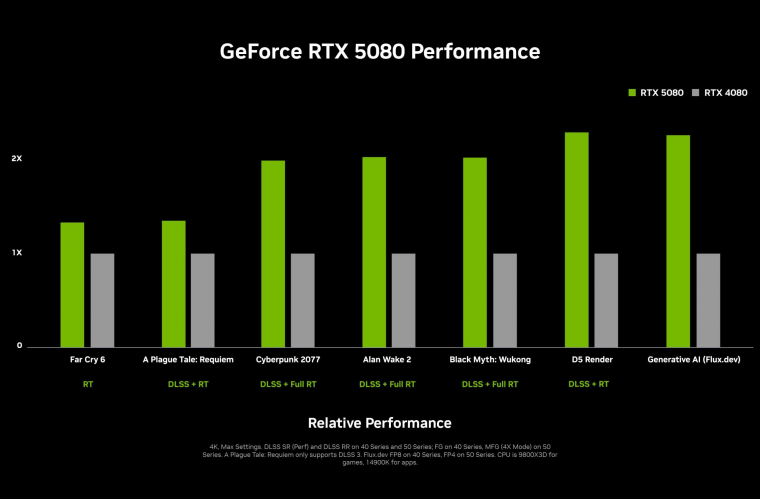
What this will be enough for exactly can be seen from the tests, due to the new generation RT cores and the increased shader performance, it can be quite close to the RTX 4090 in terms of raw power, but with the new DLSS, the advantage of the novelty is already the length of the street. The RTX 5070 Ti closely follows the 80 model, which also uses the GB203 chip, only in a configuration with 14 SM blocks less. The 8960 stream processor is no slouch either, and the 16GB GDDR7 VRAM stock remains, while the price tag keeps dropping to $749 for the Ti.
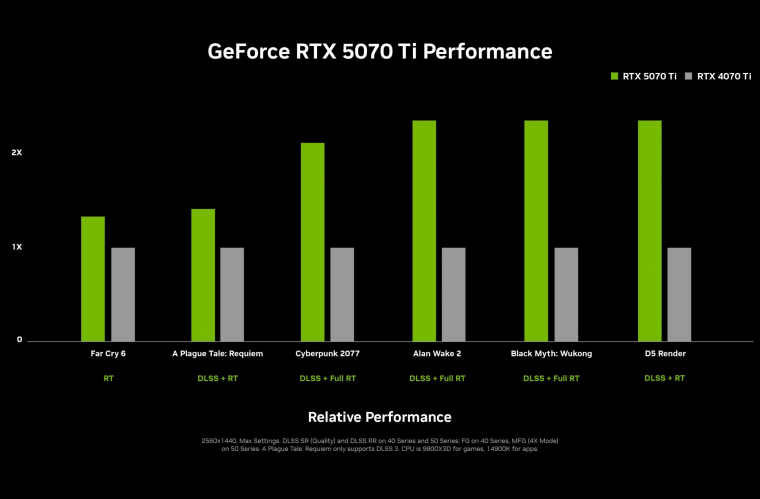
During machine development, it is worth paying a little attention to the power supply issue, most configurations can cope with the consumption limits of 360 W and 300 W, but the 16-pin power connector cannot be avoided here either. In this regard, the plain RTX 5070 has quite friendly parameters, and perhaps the 12 GB of VRAM will not create a limit in future games. The normal model using the GB205 chip is capable of slightly more than the RTX 4070 SUPER, although Nvidia considers the results measured with DLSS 4 for this model to be authoritative and immediately positions the card’s performance at RTX 4090. The asking price of $549 in exchange is tempting, but we’ll wait for tests and actual end-user prices.
The new generation soars with DLSS 4
Among the most important features of the GeForce RTX 50-series “Blackwell” GPUs is the DLSS 4 technology, which, according to the manufacturer, brings a revolutionary innovation in the field of frame generation. The development is known to use generative artificial intelligence to predict up to three future frames based on a conventionally rendered frame, which in itself results in a higher resolution.
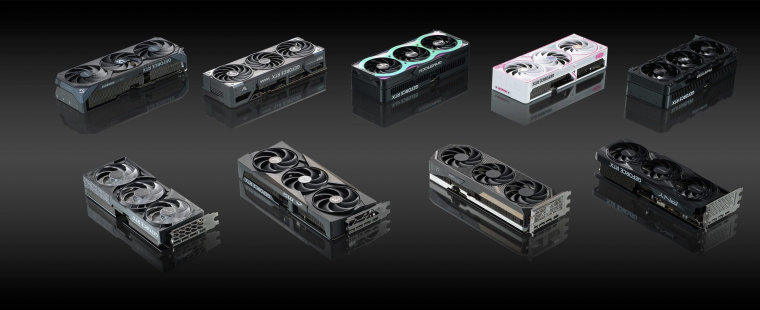
DLSS can upscale a single pixel to four, for example converting a 1080p render to 4K output, for which DLSS 4 generates three additional frames, resulting in an effective pixel generation ratio of 1:15, meaning 15 out of every 16 pixels are generated outside of the traditional rendering process. Thanks to the technology, the display of frames can be accelerated, but this ability is only compatible with RTX 50-series GPUs, which will be released at the end of the month. In addition, the previous generations are not left without performance improvements, in the case of the RTX 30 and 20 series, you can expect better image quality during upscaling, and in the case of RTX 40 cards, the efficiency of normal frame generation and the management of the resulting delay are improved.
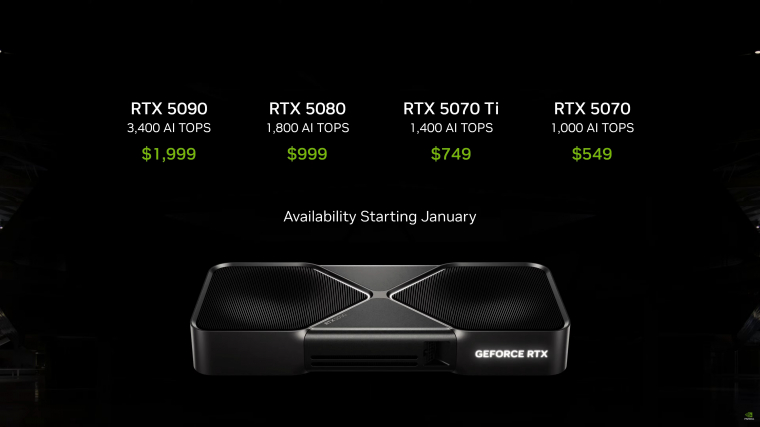
The generation change has therefore started, the RTX 5090 and 5080 are expected to be available in stores by the end of January, and the RTX 5070s will be available in the second month of the year.
Source: www.pcwplus.hu


